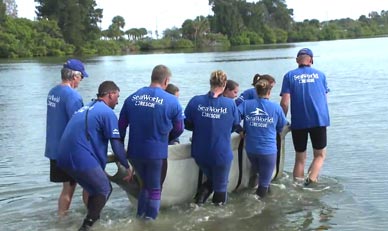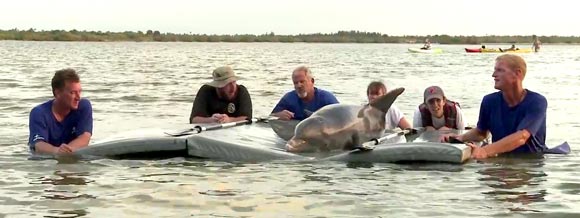SeaWorld Rescue Team Returns Dolphin To Open Water
By Space Coast Daily // November 14, 2013
dolphin found stranded in shallow waters june 13
ABOVE VIDEO: The Animal Rescue Team, working closely with researchers and dolphin experts from Hubbs-SeaWorld Research Institute Florida (HSWRI), was able to successfully reintroduce the dolphin to open waters. Take a look at this incredible return!
BREVARD COUNTY • MELBOURNE, FLORIDA – After nearly five months of care at SeaWorld Orlando, an adult male dolphin was returned to waters yesterday near Melbourne Beach, on Florida’s east coast.

The Animal Rescue Team, working closely with researchers and dolphin experts from Hubbs-SeaWorld Research Institute Florida (HSWRI), was able to successfully reintroduce the dolphin to open waters.
On June 13, the dolphin was found to be stranded in shallow waters of the Merritt Island National Wildlife Refuge. Hubbs-SeaWorld Research Institute’s research scientists were the first responder to the dolphin and our Animal Rescue Team quickly rescued and transported the dolphin to the park’s marine mammal rehabilitation facility.
CRITICAL CONDITION
At the time of rescue, the dolphin was considered to be in critical condition and appeared thin, weighing only about 350 pounds. He was also suffering from a respiratory disease. Blood and other fluid samples were taken, and medical treatment was administered.

Over the past several months, the team has continued to provide the dolphin with around-the-clock supportive and rehabilitative care, including chest x-rays and medical treatment for his respiratory disease.
During his time at the park’s marine mammal rehabilitation facility, the team made as little direct contact with the animal as possible to prevent him from becoming accustomed and dependent on humans. This was done purposefully in hopes that he would be reintroduced to the wild.
During his rehab, the dolphin gained 140 pounds and his respiratory disease cleared. After a final health assessment on November 9, the National Oceanic and Atmospheric Administration (NOAA) authorized today’s return.
INSITE INTO FEEDING & MIGRATORY PATTERNS

Prior to yesterday’s return, a high-frequency radio tag was attached to the dolphin’s dorsal fin by HSWRI research scientists. The tag, which has been designed to fall off in two to three months, will allow the team to monitor his movement, giving insight to his feeding and migratory patterns, ensuring he has acclimated well.

The dolphin’s dorsal also was marked with “R08,” which will help in future identification once the tag has fallen off.
The goal of the SeaWorld Rescue and Rehabilitation Program is to always return rescued animals back into their natural environment, but there are certain times when injuries may be too severe or the animal may have been rescued too young to be successfully returned. SeaWorld Orlando works closely with government agencies, including Florida Fish and Wildlife Conservation Commission and NOAA, to determine when, and if, rescued animals can be returned.
If you see injured marine animals, you can help by calling the FWC hotline at 1(888) 404-3922 or by dialing *FWC on a cellular device.












